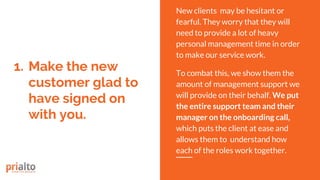Three Principles for Successful Client Onboarding
- 2. The Process of Client Onboarding Making this process successful is crucial to any service company. It is the mechanism that instills confidence in your offering. Getting this right - especially when your service is offered remotely through a globally distributed team - is even more important and difficult. At Prialto, weŌĆÖve kept the following principles in mind while structuring our onboarding process.
- 3. The Three Principles: 1. Make the new customer glad to have signed on with you. 1. Create a detailed, personal, and professional context around which to collaborate. 1. Begin taking steps to ensure continuity.
- 4. 1. Make the new customer glad to have signed on with you. New clients may be hesitant or fearful. They worry that they will need to provide a lot of heavy personal management time in order to make our service work. To combat this, we show them the amount of management support we will provide on their behalf. We put the entire support team and their manager on the onboarding call, which puts the client at ease and allows them to understand how each of the roles work together.
- 5. 2. Create a detailed, personal, and professional context around which to collaborate. Studies show that when meetings begin with a bit of personal sharing, they are more productive than the meetings kept to ŌĆ£just business.ŌĆØ We begin our onboarding calls by introducing the employees that make up the team. We outline their roles in helping the client and then ask the client to tell us about both their personal and professional life. This allows us to understand the professional life described, the personal world it takes place in, and the connections between the two.
- 6. 3. Begin taking steps to ensure continuity. New clients may be attracted to the firm because of one particular partner, employee, or executive. However, the hope should be that the service is not dependent on one or two people. Building a continuity of service starts with the onboarding call. The call should never be with one person; it should always include the broader support team.
- 7. The Onboarding Bridge The provider of the service must convince the buyer that the dip in productivity - often associated with adopting a new service - will be minimal. Simultaneously, the buyer must convince the provider that they are capable of riding out the productivity dip.
- 8. In short, a good client onboarding process will accomplish the following: ŌŚÅ Help the new customer slow down, in a time-efficient way, in order to get started. ŌŚÅ Help overcome the business and social context gap between the service provider and the service buyer. ŌŚÅ Begin the process of ensuring continuity for both the firm and the customer.
- 9. Learn more about us at www.prialto.com.









